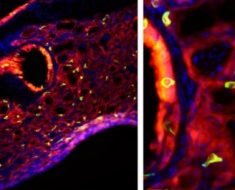TOPLINE:
Longer leukocyte telomere length is associated with higher left ventricular mass (LVM) and larger global ventricular size, as well as better cardiac function and lower risk of heart failure (HF).
METHODOLOGY:
-
The length of telomeres, the protective caps at the end of chromosomes that shorten with cell division, is usually measured in leukocytes. Evidence links shorter leukocyte telomere length (LTL) to risk of coronary artery disease (CAD) and HF.
-
The study included 40,459 participants (mean age, 55.1 years) from the UK Biobank (UKB), a large population cohort.
-
Researchers accessed data from a subset of participants who underwent cardiovascular magnetic resonance (CMR) scans, which provided measurements of cardiac structure and function, and from their recent large-scale measurement of LTL in UKB participants that identified genetic variants associated with LTL.
-
Using peripheral blood leukocyte DNA, researchers measured LTL as the ratio of telomere repeat copy number (T) relative to that of a single copy gene (S), and they stratified study participants by LTL quartile.
TAKEAWAY:
-
After accounting for differences in age, sex, height, and weight, there was a positive association between LTL and left ventricular mass (LVM) (β = 0.47; 95% CI, 0.34 – 0.60; P = 3.97 × 10−12).
-
Similarly, longer LTL was associated with larger global ventricular volume, larger overall ventricular size based on shape modeling, higher left ventricular stroke volume, higher right ventricular stroke volume, larger left atrial maximal volume, and higher left atrial emptying volume.
-
Adjustment for systolic blood pressure, diabetes, dyslipidemia, smoking status, and physical activity level slightly attenuated effect sizes while retaining the statistical significance.
-
An adjusted analysis showed longer LTL was associated with a lower risk of HF (LTL fourth quartile vs first quartile: hazard ratio, 0.86; 95% CI, 0.81 – 0.91; P < .001).
-
On the basis of multiple Mendelian randomization approaches, the study provided compelling evidence that associations of LTL with left ventricular mass, global ventricular volume, and left ventricular stroke volume could be causal, authors note.
IN PRACTICE:
The findings suggest modulation of LTL dynamics “may have a role in improving cardiovascular structure and function, which could potentially explain the observed lower future risk of heart failure,” the authors write.
SOURCE:
The study was conducted by Nay Aung, MBBS, PhD, William Harvey Research Institute, Barts and The London School of Medicine and Dentistry, Queen Mary University of London, United Kingdom, and colleagues. It was published online July 26, 2023 in JAMA Cardiology.
LIMITATIONS:
Because UKB participants are more affluent and have a healthier lifestyle and fewer comorbid conditions than the UK general population, the study has a healthy volunteer selection bias. Most of the cohort (97%) were White, which may limit generalizability of findings. Telomere length was quantified in blood leukocytes, which may not reflect cell-specific or tissue-specific telomere length. LTL and CMR measurements were obtained at different time points.
DISCLOSURES:
Study authors received support from the National Institute for Health and Care Research, the Academy of Medical Sciences, Engineering and Physical Sciences Research Council, the British Heart Foundation, the Cambridge Biomedical Research Centre, the UK Medical Research Council, the University of Southampton, the University Hospital Southampton, SmartHeart, and the Biotechnology and Biological Sciences Research Council. Disclosures of individual authors are available in the original article.
For more news, follow Medscape on Facebook, Twitter, Instagram, and YouTube.
Source: Read Full Article





